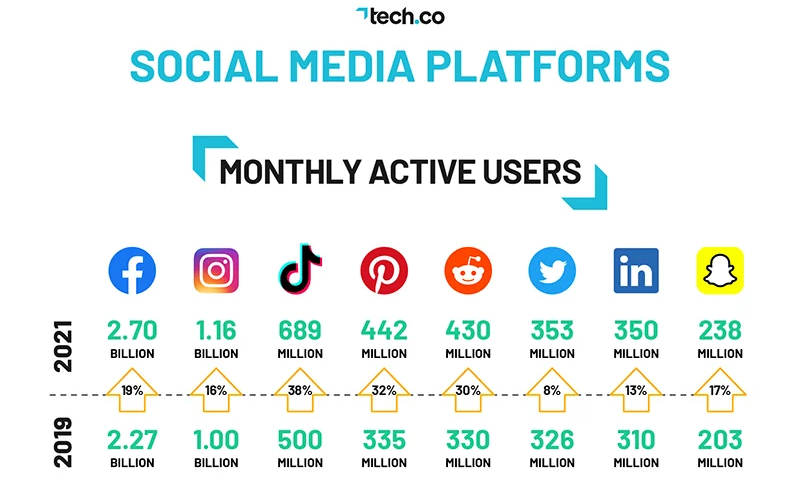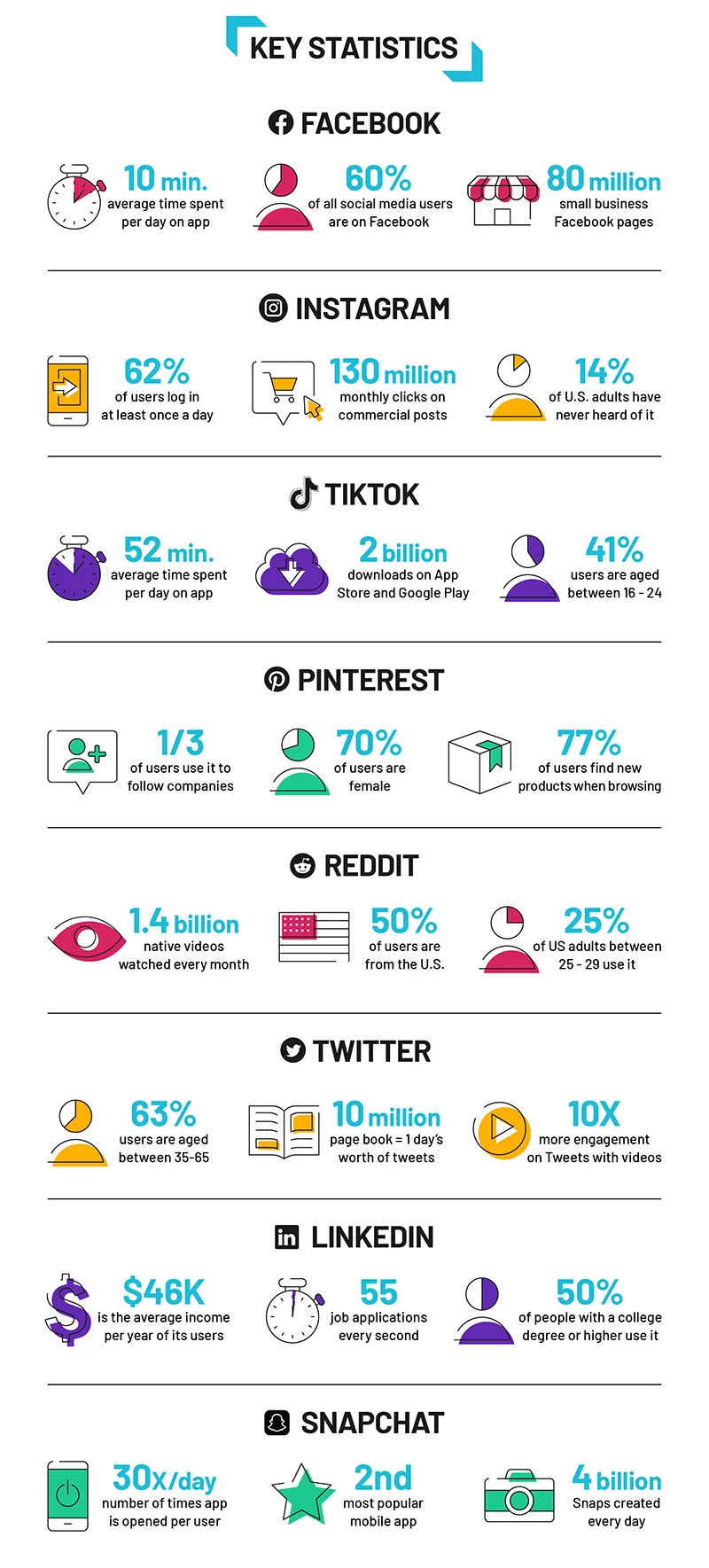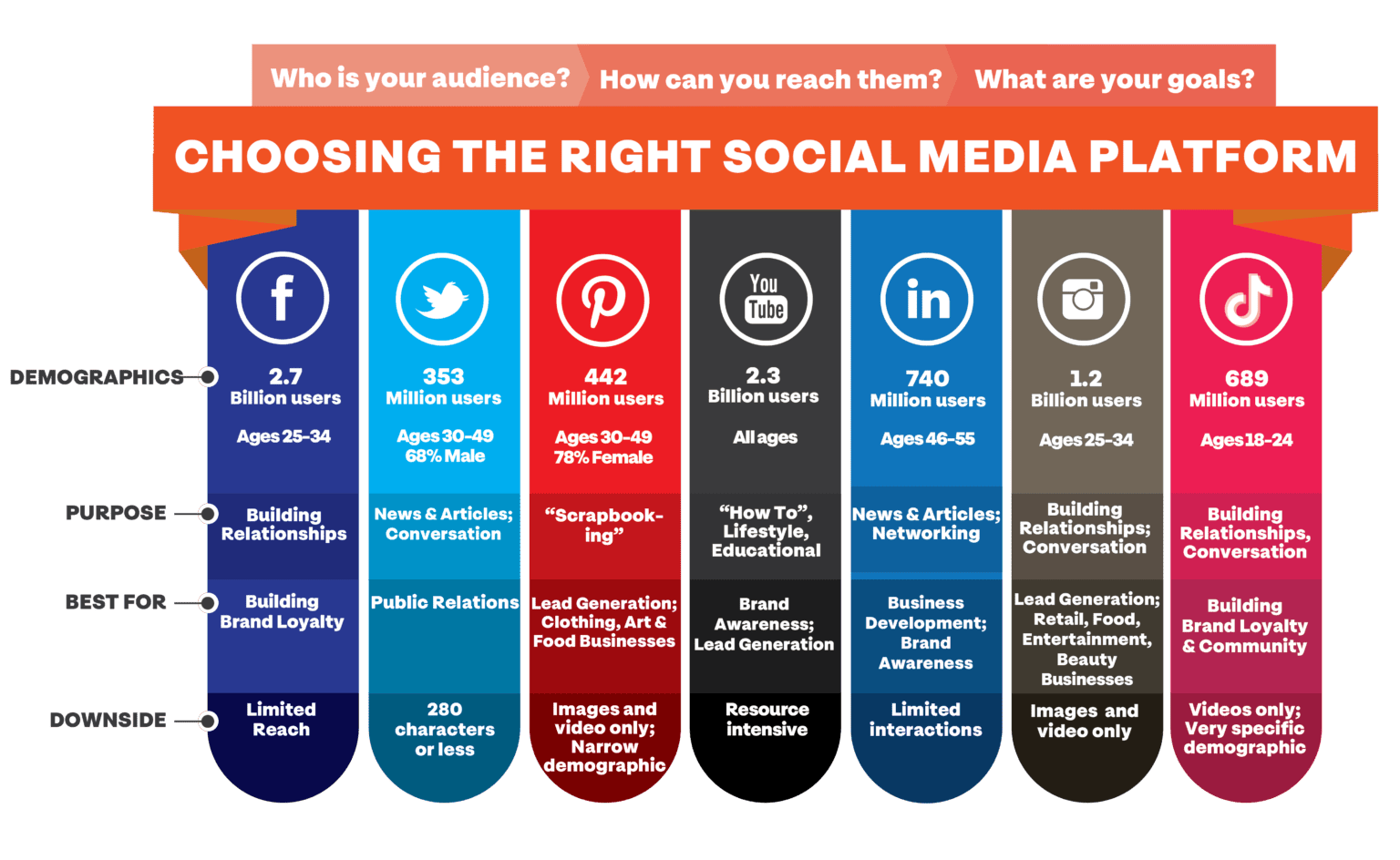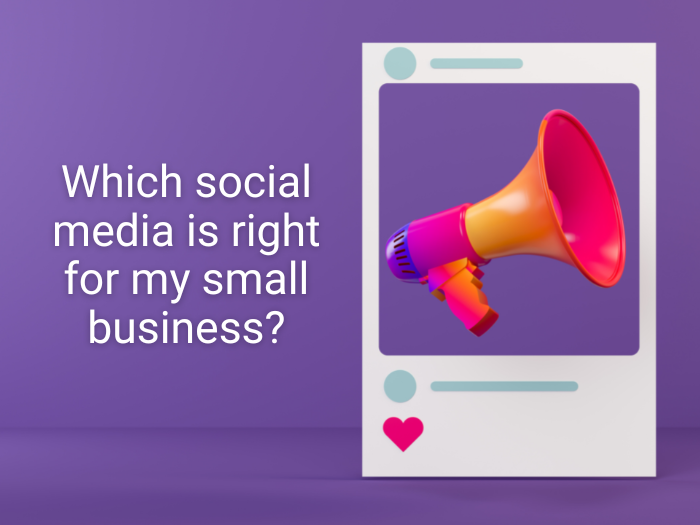In 2021, an average of 18-2 years old will run 8.4 profiles on social media. Multi-social media networking is attributed to platforms such as YouTube, Instagram, LinkedIn, Tiktok, and Facebook, according to the Omnicore Agency.
Social Network platforms almost tripled their user base in the last decade from 970M in 2010 to 4.48B users as of July 2021. According to Backlinko.com. Facebook is the leading social network with 2.9 billion monthly active users, followed by YouTube (2.3 billion), WhatsApp (2 billion), FB Messenger (1.3 billion), and WeChat (1.2 billion). In the US, 54% of social media users are female, while the remaining 46% are male, compared with a global average of 45.6% for females and 54.4% for males.

Infographic taken from SocialMediaToday
But how do we know which social media is right for your business? It is essential to focus on a few social media channels rather than all of them. Before choosing which social media site to focus on, here are some of the Pros and Cons of each social media platforms:
Pros:
- It is the most extensive user base on any social media. With enough budget and audience, Facebook could be the best way for your business’ visibility. It can help you reach the maximum number of people online the fastest.
- You can easily manage its wide range of demographic categories, including age. As other users only have one social media account (especially for older target audiences), Facebook is likely the only social media platform they have. It can reach internet users 25 years old and above.
- You can join private groups with similar interests. And now, online sellers have a marketplace to contact customers and sell their products directly. You can interact, pose questions and personalize the experience for your brand.
Cons:
- According to Global Social Media statistic research, the reach of Facebook posts is steadily declining as other users spend more time on other social media platforms. Ads require a large budget.
- There has been controversy over privacy and security data breaches over the recent years, which other users are terrified of.
Facebook remains the social media standard in so many small businesses because the presence on the platform makes it easy for many users to reach. Call to action such as “Call now” buttons and detailed analytics are very attractive to businesses. You can always focus on organic marketing if you opt out of Facebook ad campaigns.
YOUTUBE
Pros:
- If you are fond of creating videos, then a video-based platform is right for you. Easily share information with 2B monthly users. You can create how-to guides, tutorials, product descriptions, and press releases.
- It drives more conversions when done correctly using SEO.
Cons:
- Videos may take longer to produce, and users have higher expectations of visuals than any video content platform such as Tiktok.
- Ranking can be difficult. It would be best if you learned how to optimize your titles and descriptions using YouTube SEO to get more traffic and conversions to your site.
YouTube can be informative and highly valuable for a lot of users. If you are to share information, or create how-to videos, make sure you also include captions for handicap reading. It is essential for your users to understand you better and for them to share your content, thus creating massive viewership.
INSTAGRAM (IG)
Pros:
- This platform is straightforward to learn as it focuses on photos, videos, reels, and stories. Its interface is a no-brainer, sleek and simple design. If clear and compact is what you need, then Instagram is your go-to social media platform.
- You focus on the visual. And if your company sells products, it has a powerful tool for retail sales and e-commerce segments.
- Retention – if you want people to remember your product, you can creatively produce quality photos or viral videos.
- It is more famous for the younger audience. This platform is an excellent tool for lead generation.
Cons:
- Some businesses struggle to measure their ROI since they can’t contain links that help track the (click-through rates) CTRs and conversions.
Instagram is primarily visual. If you can create compelling images and videos and sell your product through visual appeal, then IG is an exciting learning platform for your small business to reach customers. You can check out some successfully marketed products through Instagram: Cluse, Letterfolk, and Bencuit.

Infographic from Red Website Design
Pros:
- If you want to make “noise,” Twitter is your go-to platform. It has a brilliant get-go strategy of allowing limited character limits. A lot of younger and even small businesses use Twitter. It is a place to feel more engaged.
- You can find different ways to monetize your platform. You can spice up your business’ standpoint by engaging your audience and adding valuable content. Your ads have more chances of being visible than on Facebook.
- You can target your customers by directly linking them through “@” or using the proper hashtag “#” to be viral.
Cons:
- Misuse of gaffs such as wrong hashtags can also turn away customers.
Many people go to Twitter for current events, making it very timely for small businesses to use the platform for updates. You can even create your hashtag efficiently. And if you know better, then go ahead and use Twitter.
Pros:
- 4/5 of Pinterest users are female, and according to Bloomberg, women drive up to 80% of household purchasing decisions.
- Often, users visit the platform specifically to discover and compare food, home, beauty, or fashion products. As a result, Pinterest has a higher CTR than other social media platforms.
Cons:
- Restrictions to paid posts. Some local businesses cannot use this for paid advertisements.
If you are product based, your small business can benefit from Pinterest. Small businesses use this product to showcase themselves and will link their Etsy, Amazon Handmade, and eBay. Small businesses that make handmade products or fashion ideas often make it on Pinterest. Even designs are now defined as “Pinterest-look.”
TIKTOK
Pros:
- Short-form videos called reels focus on visuals and retention. Building brand awareness is straightforward with short videos. This is the trendiest platform to capture fun and social attention.
- Businesses like art, beauty, and services are trendy amongst younger audiences. Has now over 800M active users worldwide
Cons:
- Demographic is very young (targeting the age of 18-24) and may not exceptionally be consumers.
- Conversion isn’t possible as you can’t link videos to your website. Analytics can be challenging as it only shows 28 days of organic data analytics.
- It is banned in several countries due to data sharing and legal concerns.
To summarize

Infographic from AOFund.org
To fully engage in a certain platform, you first need to understand your market.
- Identifying your target audience and your marketing budget for social media.
- Define the goal of your campaign. What will your creative goals be and how can you achieve them?
- Find your niche and your audience. Understanding who these audiences are will help you acknowledge your market.
- How much time do you need when promoting your product or service on social media?
- Understanding your conversion rate. It is very necessary to learn and understand conversion rate as it helps with your ROI.
- How customers interact with your brand.
- Benchmarking your social platforms.
When you have defined your goals and objectives, allocating your social media budget and aligning your company’s goals with your chosen platform, then you can start creating your social media ads. Remember: social media is all about engagement, without engagement, all your efforts will be wasted. Engagement also entails conversion. Learn which social media is more effective for your business and your business will flourish.
